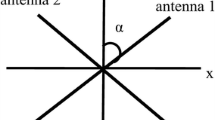Abstract
The correlation among signals arriving at different elements of the antenna array has a significant impact on the performance of multiple-input multiple-output (MIMO) system. To investigate the inter-element correlation when slant polarized antennas are used, a general approach for calculating the correlation coefficient is proposed based on a model that incorporates the antenna configuration, namely the antenna spacing and the slant angle, as well as the channel parameters, such as the power azimuth spectrum (PAS) and the crosspolarization discrimination (XPD). By applying this method to the 3rd generation partnership project (3GPP) spatial channel model (SCM), the expression of the inter-element correlation when the PAS follows the Laplacian distribution is obtained. The approximate expressions are also given for two special cases, i.e., the case where the angular spread (AS) of the PAS is small, and the case where the AS is so large that the PAS can be approximated by the uniform distribution. Using these expressions, the impact of the antenna configuration and the channel parameters on the correlation is analyzed. Following that, the trend of inter-element correlation with the slant angle is investigated. Finally, the equivalent relation between the slant angle and the antenna spacing is studied. The results can provide guidelines for the antenna configuration under different propagation conditions.
Similar content being viewed by others
References
Foschini G J, Gans M J. On limits of wireless communications in a fading environment when using multiple antennas. Wirel Pers Commun, 1998, 6: 311–335
Zheng L, Tse D. Diversity and multiplexing: a fundamental tradeoff in multiple-antenna channels. IEEE Trans Inf Theory, 2003, 49: 1073–1096
Suvikunnas P, Salo J, Vuokko L, et al. Comparison of MIMO antenna configurations: Methods and experimental results. results. IEEE Trans Veh Technol, 2008, 57: 1021–1031
Ichitsubo S, Tsunekawa K, Ebine Y. Multipath propagation model of observed at base station in urban areas. IEEE J Sel Areas Commun, 2002, 20: 1204–1210
Fukushige M, Imai T. Analysis of polarization diversity gain at base station in W-CDMA system. IEICE Trans Commun, 2007, E90-B: 2360–2368
Lo H C, Lin D B, Yang T C, et al. Effect of polarization on the correlation and capacity of indoor MIMO channels. Int J Antennas Propag, 2012, 2012: 246348
Liolis K P, Gomez-Vilardebo J, Casini E, et al. Statistical modeling of dual-polarized MIMO land mobile satellite channels. channels. IEEE Trans Commun, 2010, 58: 3077–3083
Valenzuela-Valdes J F, Garcia-Fernandez M A, Martinez-Gonzalez A M, et al. Evaluation of true polarization diversity for MIMO systems. for MIMO systems. IEEE Trans Antennas Propag, 2009, 57: 1924–1934
Forenza A, Love D J, Heath R W. Simplified spatial correlation models for clustered MIMO channels with different array configurations. array configurations. IEEE Trans Veh Technol, 2007, 56: 1924–1934
Pedersen K I, Mogensen P E, Fleury B H. Spatial channel characteristics in outdoor environments and their impact on BS antenna system performance. In: Proceedings of IEEE 48th Vehicular Technology Conference, Ottawa, 1998.719–723
Bhagavatula R, Heath R W. Computing the receive spatial correlation for a multi-cluster MIMO channel using different array configurations. In: Proceedings of IEEE Global Telecommunications Conference, New Orleans, 2008. 1–5
Brown T W C, Saunders S R, Stavrou S, et al. Characterization of polarization diversity at the mobile. IEEE Trans Veh Technol, 2007, 56: 2440–2447
Quitin F, Oestges C, Horlin F, et al. Multipolarized MIMO channel characteristics: Analytical study and experimental results. results. IEEE Trans Antennas Propag, 2009, 57: 2739–2745
Valenzuela-Valdes J F, Martinez-Gonzalez A M, Sanchez-Hernandez D A. Accurate estimation of correlation and capacity for hybrid spatial-angular MIMO systems. capacity for hybrid spatial-angular MIMO systems. IEEE Trans Veh Technol, 2009, 58: 4036–4045
Wong K, Wu Y. Spatial-polarizational correlation-coefficient function between receiving-antennas in radiowave communications-geometrically modeled, analytically derived, simple, closed-form, explicit formulas. communications-geometrically modeled, analytically derived, simple, closed-form, explicit formulas. IEEE Trans Commun, 2009, 57: 3566–3570
3GPP. Spatial channel model for multiple input multiple output (MIMO) simulations (Rel. 6). TR 25.996, 2003
Zhang Y, Zhang J, Liu G, et al. Impact of randomized cross-polarization discrimination on channel correlation property of the 3GPP spatial channel model. IEICE Trans Commun, 2009, E92.B: 1300–1307
Liang Y, Zhang J, Zhang Y, et al. Investigation of polarization configurations and the impacts on fading correlation characteristics. In: Proceedings of IEEE 70th Vehicular Technology Conference Fall, Anchorage, 2009. 1–5
Nikiforov A F, Uvarov V B. Special Functions of Mathematical Physics. Birkhauser, 1988
Vaughan R, Andersen J. Antenna diversity in mobile communications. IEEE Trans Veh Technol, 1987, 36: 149–172
Author information
Authors and Affiliations
Corresponding author
Rights and permissions
About this article
Cite this article
Nie, X., Zhang, J. & Zhang, P. Investigation on the spatial-polarizational correlation based on 3GPP spatial channel model. Sci. China Inf. Sci. 57, 1–12 (2014). https://doi.org/10.1007/s11432-013-4783-z
Received:
Accepted:
Published:
Issue Date:
DOI: https://doi.org/10.1007/s11432-013-4783-z



